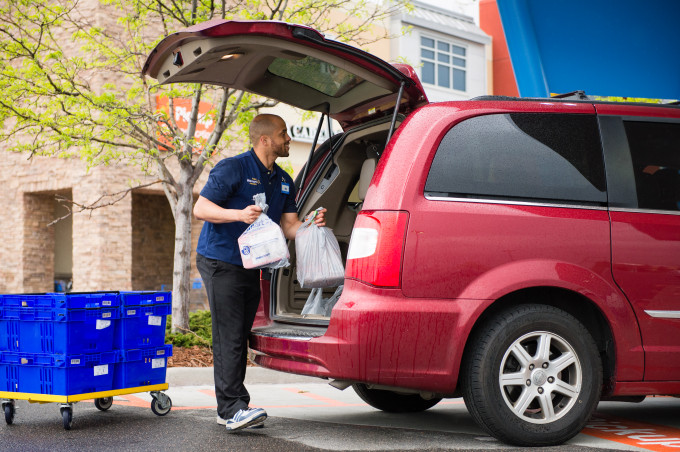
The USDA this morning announced the launch of a pilot program that will open up online grocery shopping to those on public assistance. During a two-year pilot program, those receiving SNAP (Supplemental Nutrition Assistance Program) benefits — often referred to as “food stamps” — will be able to shop for groceries from online retailers, including Walmart, Amazon and, soon, ShopRite and others. The pilot is live in New York state at launch, with availability that varies by retailer.
Amazon’s program will encompass the grocery and household selections available on both AmazonFresh and Prime Pantry, the retailer says, without the requirement of a membership fee. This program will operate only in the New York City area, as will ShopRite, when it joins the pilot next week.
Meanwhile, Walmart’s pilot will cover grocery pickup and delivery in upstate New York locations.
The USDA says other retailers are expected to join the pilot in the months ahead. Eventually, the program will also expand to other areas in New York and beyond, including Alabama, Iowa, Maryland, Nebraska, New Jersey, Oregon and Washington.
Plans for the program have been in the works for years. The 2014 Farm Bill authorized the USDA to conduct and evaluate a pilot for online purchasing using SNAP, before rolling out support nationwide. During this pilot, the goal is to test that SNAP benefits are processed safely and securely, and to better understand the challenges involving online acceptance of SNAP.
This is also the first time that SNAP participants will be able to order grocery delivery online — something that the USDA believes should no longer be considered a luxury.
At times, online retailers can offer lower prices on items, which can benefit budget shoppers. Plus, not all online grocery items are marked up, versus what you can buy in store. That tends to be more true for fast delivery services like Instacart or Shipt. Walmart, for example, charges the same prices for its online groceries as it does in stores. And when free delivery is offered, SNAP recipients can save both time and gas. (SNAP will only cover food items, not delivery or other fees.)
These are all the same perks that any e-commerce shopper enjoys, but can be even better appreciated by those who don’t have a car, can’t afford gas or work multiple jobs trying to make ends meet and don’t have time to shop.
“People who receive SNAP benefits should have the opportunity to shop for food the same way more and more Americans shop for food – by ordering and paying for groceries online. As technology advances, it is important for SNAP to advance too, so we can ensure the same shopping options are available for both non-SNAP and SNAP recipients,” said Secretary of Agriculture Sonny Perdue, in a statement. “We look forward to monitoring how these pilots increase food access and customer service to those we serve, specifically those who may experience challenges in visiting brick and mortar stores,” he added.
The pilot program will involve the use of electronic benefit (EBT) cards issued by New York to allow for the online purchasing. Walmart and Amazon are live today, with ShopRite and others joining in the weeks ahead.
Amazon says the program will “dramatically increase access to food for more remote customers and help to mitigate the public health crisis of food deserts,” — a reference to areas where it’s difficult to find healthy food choices, which leads to Americans opting for convenience foods and fast foods instead. This, in turn, can lead to further health problems down the road.

The USDA today proclaimed this is the “first time SNAP customers can pay for their groceries online.” That’s true, but comes with a caveat. In 2017, Walmart began EBT acceptance for groceries bought online starting in one store in the Houston market and four more in Boise. Its program supported SNAP and EBT Cash / TANF but not WIC. However, those customers could only order grocery pickup, not delivery.
The difference between that program and the USDA’s program, Walmart clarified to TechCrunch, is that SNAP recipients would have to pay for their groceries at the pickup location by choosing “Pay at Pickup” at checkout. Walmart wasn’t actually processing the transactions online, but rather in a parking stall at the Walmart store.
Walmart says it has since expanded that earlier SNAP at Pickup program to 40 stores across several states. For the USDA program, however, it has nearly 275 Grocery Pickup stores in the nine eligible states where the pilot is set to run.
“We are excited to be part of the USDA’s pilot program and to be able to make our Grocery Pickup and Delivery service available to more and more people, regardless of their payment method,” a Walmart spokesperson said. “Access to convenience and to quality, fresh groceries shouldn’t be dictated by how you pay. This pilot program is a great step forward and we are eager to expand this to customers in other states where we already have a great online grocery business.”
Amazon has also rolled out support to those on public assistance before today.
In 2017, it launched a low-cost version of Prime for U.S. customers with a valid EBT card, and later followed by offering low-cost Prime to Medicaid recipients last year.
Other retailers who were selected for the USDA pilot include Dash’s Market, FreshDirect, Hy-Vee, Safeway and Wright’s Markets. They are not yet live.

